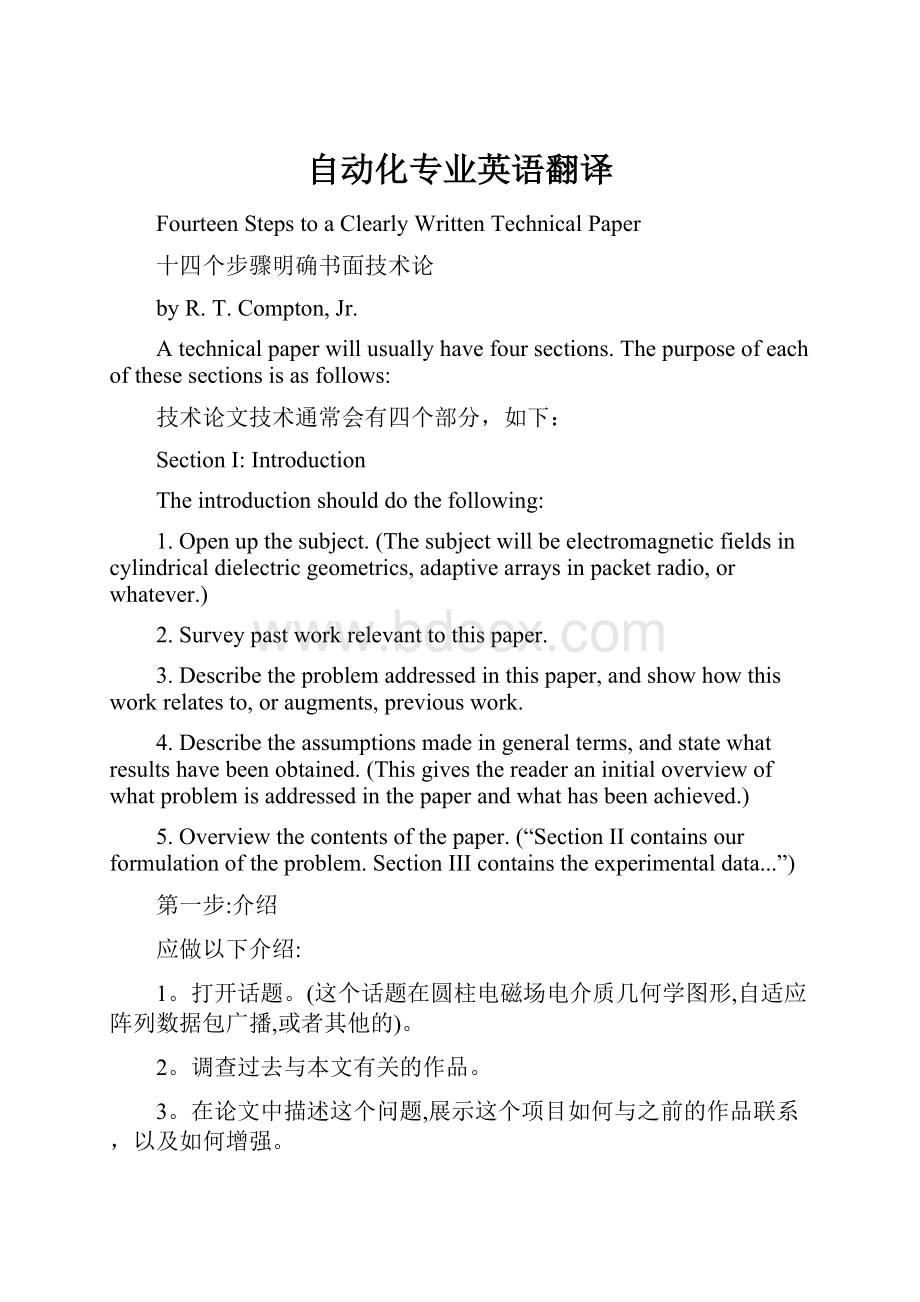自动化专业英语翻译.docx
《自动化专业英语翻译.docx》由会员分享,可在线阅读,更多相关《自动化专业英语翻译.docx(11页珍藏版)》请在冰豆网上搜索。

自动化专业英语翻译
FourteenStepstoaClearlyWrittenTechnicalPaper
十四个步骤明确书面技术论
byR.T.Compton,Jr.
Atechnicalpaperwillusuallyhavefoursections.Thepurposeofeachofthesesectionsisasfollows:
技术论文技术通常会有四个部分,如下:
SectionI:
Introduction
Theintroductionshoulddothefollowing:
1.Openupthesubject.(Thesubjectwillbeelectromagneticfieldsincylindricaldielectricgeometrics,adaptivearraysinpacketradio,orwhatever.)
2.Surveypastworkrelevanttothispaper.
3.Describetheproblemaddressedinthispaper,andshowhowthisworkrelatesto,oraugments,previouswork.
4.Describetheassumptionsmadeingeneralterms,andstatewhatresultshavebeenobtained.(Thisgivesthereaderaninitialoverviewofwhatproblemisaddressedinthepaperandwhathasbeenachieved.)
5.Overviewthecontentsofthepaper.(“SectionIIcontainsourformulationoftheproblem.SectionIIIcontainstheexperimentaldata...”)
第一步:
介绍
应做以下介绍:
1。
打开话题。
(这个话题在圆柱电磁场电介质几何学图形,自适应阵列数据包广播,或者其他的)。
2。
调查过去与本文有关的作品。
3。
在论文中描述这个问题,展示这个项目如何与之前的作品联系,以及如何增强。
4。
做一般的假设,以及声明得到什么。
(这给读者一个
初步的概述,以及是如何实现。
)
5。
概述论文的内容。
(“第二部分包含我们的构想这一问题。
第三部分包含实验数据……”)
SectionII:
FormulationoftheProblem
Thissectionshoulddothreethings:
1.Definetheproblemtobeconsideredindetail.Typicallythissectionmightbeginwithsomethinglike:
“Considerapacketradiosystemconsistingofasinglecentralrepeatersurroundedbyuserterminals.EachusertransmitspacketstothecentralrepeaterusingaslottedALOHAprotocol.Thetransmissionsfromallusersareassumedtobeonthesamefrequency...”Thediscussionshouldproceedinthiswayuntiltheproblemiscompletelydefined.
2.Defineallterminologyandnotationused.Usuallytheterminologyandnotationaredefinedalongwiththeproblemitself.
3.Developtheequationsonwhichyourresultswillbebasedand/ordescribeanyexperimentalsystems.
第二部分:
问题的描述
这部分该做三件事:
1。
定义要考虑的问题细节。
通常这部分可能开始可以这样说:
“考虑一个包无线电系统组成的一个单一的中央中继器被用户终端。
每个用户发送数据包到中央中继器使用开槽ALOHA协议。
所有用户的传输假定在同一频率……”应该以这种方式进行的讨论直到完全定义的问题。
2。
定义所有的术语和符号使用。
通常情况,术语和符号被定义为问题本身。
3。
开发你的方程将建立和/或描述任何结果实验系统。
SectionIII:
Results
Thissectionpresentsthedetailedresultsyouhaveobtained.Ifthepaperistheoretical,youwillprobablyshowcurvesobtainedfromyourequations.Ifthepaperisexperimental,youwillbepresentingcurvesshowingthemeasurementresults.Inordertochoosethepropercurvestopresent,youmustfirstbeclearwhatpointyouaretryingtoconveytothereader.Thecurvescanthenbechosentoillustratethispoint.Whetheryourpaperistheoreticalorexperimental,youmustprovideacarefulinterpretationofwhatyourresultsmeanandwhytheybehaveastheydo.
第三部分:
结果
本节介绍了你获得的详细的结果。
如果这篇论文理论上,你可能会间接从你的方程式中得到。
如果这篇论文是实验,你会提出曲线显示测量结果。
为了选择适当的曲线,你必须首先清楚知道你想传达给读者的东西是什么。
然后才可以选择曲线来描述。
你的论文是理论还是实验,你必须提供严谨的结果来解释你的结果和为什么他们会是这样的。
SectionIV:
Conclusion
Thissectionshouldsummarizewhathasbeenaccomplishedinthepaper.ManyreaderswillreadonlytheIntroductionandConclusionofyourpaper.TheConclusionshouldbewrittensotheycanbeunderstoodbysomeonewhohasnotreadthemainworkofthepaper.Thisisthecommonformatforanengineeringpaper.Ofcourse,thenamesofthesectionsmaydifferslightlyfromthoseabove,butthepurposeofeachsectionwillusuallybeasdescribed.Somepapersincludeadditionalsectionsordifferfromtheaboveoutlineinonewayoranother.However,theoutlinejustpresentedisagoodstartingpointforwritingatechnicalpaper.
Towriteyourpaper,youshouldproceedasfollows:
第四部分:
结论
这部分总结应该在本文完成之前。
许多读者只会阅读你论文中的介绍和总结。
所以结论应该写成即使没有读过论文主题部分也能理解这篇论文的样子。
这是一个对于工程论文通用的格式。
当然,部分的名字可能和以上的不同,但每个部分的目的就和以上说的一样。
一些论文会从不同方式中增加栏目或者有一些不一样的部分。
然而,这些概述只是提出了一个写好一篇论文的轮廓而已。
写论文,你该沿着如下写的去做:
Step1:
Startbywritingacompletefirstdraftofyourpaper,exceptfortheIntroductionandConclusion.(ItiseasiesttoleavetheIntroductionandConclusionuntilafterthemainbodyofthepaperiswritten.)Inwritingyourpaper,keepthefollowinginmind:
1.Youmustalwayspresentthebigpicturefirstandthenworktowardsthedetails.Theotherwayaroundwillnotwork.ThisisespeciallytrueinthebeginningofSectionII,whereyouareexplainingtheproblemyouarestudying.
2.Ifyougetstuckandcannotfigureouthowtoexplainsomething,ausefultrickistoimaginethatyouaretellingaverygoodfriendwhatyouareworkingon:
justputdownthewordsasyouwouldsaythemtoyourfriend.Inwritingyourfirstdraft,donotworryifthewordingisnotperfect.Polishingthedocumentcomeslater.Whenyouarefinishedwithyourfirstdraft,putitawayforacoupleofdaysbeforeyoubeginStep2.
第一步:
首先起草一个完整的论文方案,除了介绍和结论。
(这是最简单的离开介绍和结论直到论文的主体写)。
写你的论文,记住:
1。
你要一直有大局观,然后在细节上努力。
其它方式不会起到好的效果。
在你解释你正在研究的问题的这个第二部分时,这个技巧更是很受用。
2。
如果你受困于不能确定如何解释一些东西,一个有用的技巧就是想象一下,你告诉一个非常好朋友你是做什么:
把这句话你会说他们你的朋友。
在写你的初稿,请不要担心的措辞是不完美的。
之后再雕琢你的文字。
当你和你的初稿完成,把它放下几天后你再开始的第二部步。
Step2:
Makesuretheideasinthepaperareintherightorder.Ifnot,moveblocksofthepaperaroundwithyourtexteditoruntiltheyare.Askyourself:
“Canthereaderunderstandeverypassagestrictlyfromthematerialuptothatpoint?
”Ifnot,addmaterialormoveideasaround.Makesuretherearenotgapsinyourlogicalarguments,andmakesureyouarenotimplicitlyassumingthatthereaderunderstandssomethingneededtofollowyourarguments,eventhoughyouhavenotstatedit.Thereaderprobablyunderstandslessthanyouthink.
步骤2:
确保想法是以正确的顺序。
如果不是,在编辑器里面调整直到正确为之。
问问你自己:
“读者可以完全理解每一个通道从材料得到的东西吗?
“如果不是这样,添加材料或移动的想法。
确定你的逻辑没有漏洞,并确保你不是隐式地假定读者了解一些需要跟进你的论点,即使你没有说它。
读者了解的东西可能比你预想的要少。
Step3:
Workonthetransitionsbetweenideas.Makesurethatateachstagethereaderhasaroadmapofwhereheorsheisgoing.Thereadermustbeabletoseethebigpicture.Atthebeginningofeachsection,makecleartothereaderinadvancewhatthepurposeofthatsectionwillbeandhowthatsectionrelatestotheprecedingmaterial.Attheendofeachsection,youmayalsowanttoremindthereaderthatyouhavenowcompletedwhatyousetouttodointhatsection.Thenpointoutwhatthepurposeofthenextsectionwillbe,andsoforth.Theseconnectingstatementsarecalledtransitions.Thereadermustalwaysbeabletoseewhereyouaregoingandwhyandhowfaryouhaveprogressed.
第三步:
花心思在不同的想法中转换。
确保在每个阶段的读者有一个路线图,他或她去哪里。
确保读者必须能够看到整体。
在每一段的开头,先向读者清楚地知道这一段的目的是什么,以及如何与前面的材料有关。
在每一节的结尾,你可能还想提醒读者,你现在已经完成了你在这一段中所做的。
然后指出下一节的目的是什么,等等。
这些连接语句称为转换。
读者必须始终能够看到你将要去哪里,以及为什么和你有多远。
Step4:
Checkeachparagraphforunity.Eachparagraphshouldhaveonemainpoint.Usuallythecentralpointofeachparagraphisstatedinatopicalsentenceatthebeginningoftheparagraph,butnotalways.Youshouldnotmixdifferentideas
togetherinthesameparagraph.Ifyouarehavingtroublegettingacertainsectionofyourpapertosoundright,gothroughthatsectiononeparagraphatatimeandaskyourselfwhatthemainpointofeachparagraphis.Foggywritingisoftenduetomixed-upparagraphs.
步骤4:
检查每一段,确保一致。
每个段落都应该有一个主观点。
通常,中心点段落是在一个局部句子段落的开头,但不是总是如此。
你不应该混合不同的想法在相同的段落。
如果你在得到一个听起来正确的部分中遇到困难,就先继续这一段并且询问自己,到底每一段的主观点是什么。
模糊不清的文章往往是由于段落混乱。
Step5:
Workonthesentencestoreducethefogindex.TheFogIndexFisdefined
asF=0.4(L+P),whereListheaveragenumberofwordspersentenceandPistheaveragenumberofpolysyllablesper100wordsoftext[1].(Apolysyllableisawordwiththreeormoresyllables.)ToevaluatetheFogIndexforyourpaper,countthenumberofwordspersentenceandthenumberofpolysyllablesper100wordsforarepresentativeportionofyourpaperfiveorsixhundredwordslong.Ideally,youshouldstriveforafogindexlessthan10.Intechnicalwriting,itissometimesdifficulttogettheFogIndexbelow10,butaFogIndexabove15isawarningthatyourmaterialwillbeveryhardforareadertofollow.
Considerthefollowingexamplestakenfromtypicalofficememos.Notethatbothmemossaythesamething.
FogIndex=35:
“Inordertoeliminatethepossibilityoferrorsoccurringinthetime
throughtranspositionofnumbersortypingerrors,eachoftheDivisionPlanningOfficesshouldsetupafileoftimecardsshowingallauthorizedprojectnumbers
andmakeadailycheckofthechargesonAccountingDepartmenttobesurethatonlyauthorizednumbersareused.”(1sentence,69words,13polysyllables)FogIndex=11:
“Itiseasytotransposedigitsandmaketypingerrorswhenenteringprojectnumbers.WesuggesteachDivisionPlanningOfficesetupafileoftimecardsshowingallauthorizedprojectnumbers.Thenallchargesshouldbe
checkedeachdaybeforesendingtimesheetstotheAccountingDepartment.”(3sentences.48words,5polysyllables)
Toreducethefogindex,youmustdotwothings:
(1)reducethelengthofyoursentences(bybreakinglongsentencesintoshorterones),and
(2)getridofasmanycomplicatedwordsaspossible(byusingsimplerwordsinstead).
第五步:
减少字句中的模糊指数。
模糊指数F定义作为F=0.4(L+P),其中L是平均水平每个句子的单词数量和P平均每100多音节词的话语文本[1]。
(多音节词是词有三个或三个以上音节)。
评估模糊索引你的论文数每句子和单词量每100字多音节词代表你的论文5的一部分或六百字。
理想情况下,您应该争取模糊指数小于10。
在技术写作,有时很难得到模糊指数低于10,但是模糊指数高于15是一个警告你的材料将会为读者非常困难跟随。
考虑下面的例子从典型的办公备忘录。
请注意,这两个备忘录说,同样的事情。
模糊指数=35:
“为了消除错误发生在时间的可能性费用与工程相关工作,通过换位的数字或打字错误,每个部门的计划办公室应该建立一个文件的时间卡显示所有授权的项目数字每天检查的费用表转发到会计部门,以确保只有经过授权的使用数量。
”(1句子,69字,13多音节词)
模糊指数=11:
"很容易调换当数字,让打字错误进入项目数字。
我们建议每部门规划办公室成立了一个文件时间卡显示所有授权项目数字。
然后所有指控每天检查之前发送的时间表到会计部门。
”(3句子。
48个单词,5多音节词)
减少模糊指数,你必须做两个事情:
(1)减少长句子(通过将长句分解成短的),
(2)尽可能少用复杂的词(用简单的词代替)。
Step6:
Getridofasmanypassiveverbsaspossible.Alwayscheckyourpaperforpassiveverbs.(“Thedataweremeasuredandtheresultswerecorrelated.”)Changeasmanyverbsaspossibleintotheactiveform.(“Wemeasuredthedataandcorrelatedtheresults.”)Usingtoomanypassiveverbsmakesyourwritingboring.Editor’scomment:
Attheirworst,passivev